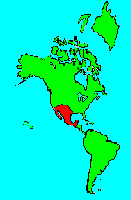SPECIES INFO
Nolina microcarpa as found from western Texas to Arizona and south into northern Mexico. These basal clumped leaves can reach about 4 feet in height. The leaves are tough, but lack marginal spines. The white flower panicle reaches above the leaves, and this cluster can cover about 3 feet of the 8 foot height of the flower stalk. . Sometimes this cluster bends over.Bear grass (Genus Nolina) is a genus related to the Yucca genus and found in the Agave family. There are about 24 species in total, and this genus is found primarily in the south western USA and Mexico. There are about 12-14 species found in North America. However, one species can be found in Guatemala, and one species can be found in the state of Georgia in the USA, and two more in Florida.
These plants have a woody base that sometimes is below ground, The numerous leaves are long and narrow. These leaves are not prickly, but may be toothed. The small crowded flowers can be in tall panicles that usually reach above the leaf cluster. Munz in the California flora notes "Perennial with a yuccalike aspect".
Yuccas and Agaves (Family Agavaceae) are sometimes combined with the Amaryllidaceae. Here they are presented as a separate family containing almost 600 species within about 18 different genera. There are 94 species organized into 11 genera now growing in greater North America. This family is naturally found from western North America south through Central America to much of northwestern South America.
These plants typically have succulent leaves. They typically have many flowers in their inflorescence. They can be herbs, shrubs, or even trees.
Lily Order (Order Liliiflorae) contains several families many of which are noted for their beautiful flowers. In addition to the rushes, this order contains the well-known lily family. Although some authors combine them with the lilies, here the Amaryllis, Iris, and Agave groups are presented in separate families.
Monocots are a large group of plants usually characterized by having leaves with parallel veins and a seed with a single shell. Most flowers are created with multiples of three. In the older botany texts, the Monocots were considered more primitive than the Dicots. However, many recent authors have placed the Monocots as an offshoot of the primitive Dicots. Here they are placed before the Dicots.
In l951 Lawrence at Cornell published a very detailed plant taxonomy for vascular plants. His taxonomy is very useful as he provided both a detailed explanation and also covered many genera. In the l990s Cronquist published a new plant taxonomy that improved the older taxonomy based on new knowledge. About the same time, Dahlgren published a different taxonomy.
Seed plants (Phylum Embryophyta) are generally grouped into one large phylum containing three major classes: the Gymnosperms, the Monocots, and the Dicots. (Some scientists separate the Gymnosperms into a separate phylum and refer to the remaining plants as flowering plants or Angiospermae.)
For North American counts of the number of species in each genus and family, the primary reference has been John T. Kartesz, author of A Synonymized Checklist of the Vascular Flora of the United States, Canada, and Greenland (1994). The geographical scope of his lists include, as part of greater North America, Hawaii, Alaska, Greenland, Puerto Rico, and the Virgin Islands.
Kartesz lists 21,757 species of vascular plants comprising the ferns, gymnosperms and flowering plants as being found in greater North America (including Alaska, Hawaii, Greenland, Puerto Rico and the Virgin Islands.
There are estimates within the scientific world that about half of the listed North American seed plants were originally native with the balance being comprised of Eurasian and tropical plants that have become established.
Plant kingdom contains a large variety of different organisms including mosses, ferns, and seed plants. Most plants manufacture their energy from sunlight and water. Identification of many species is difficult in that most individual plants have characteristics that have variables based on soil moisture, soil chemistry, and sunlight.
Because of the difficulty in learning and identifying different plant groups, specialists have emerged that study only a limited group of plants. These specialists revise the taxonomy and give us detailed descriptions and ranges of the various species. Their results are published in technical journals and written with highly specialized words that apply to a specific group.
On the other hand, there are the nature publishers. These people and companies undertake the challenging task of trying to provide easy to use pictures and descriptions to identify those species.


